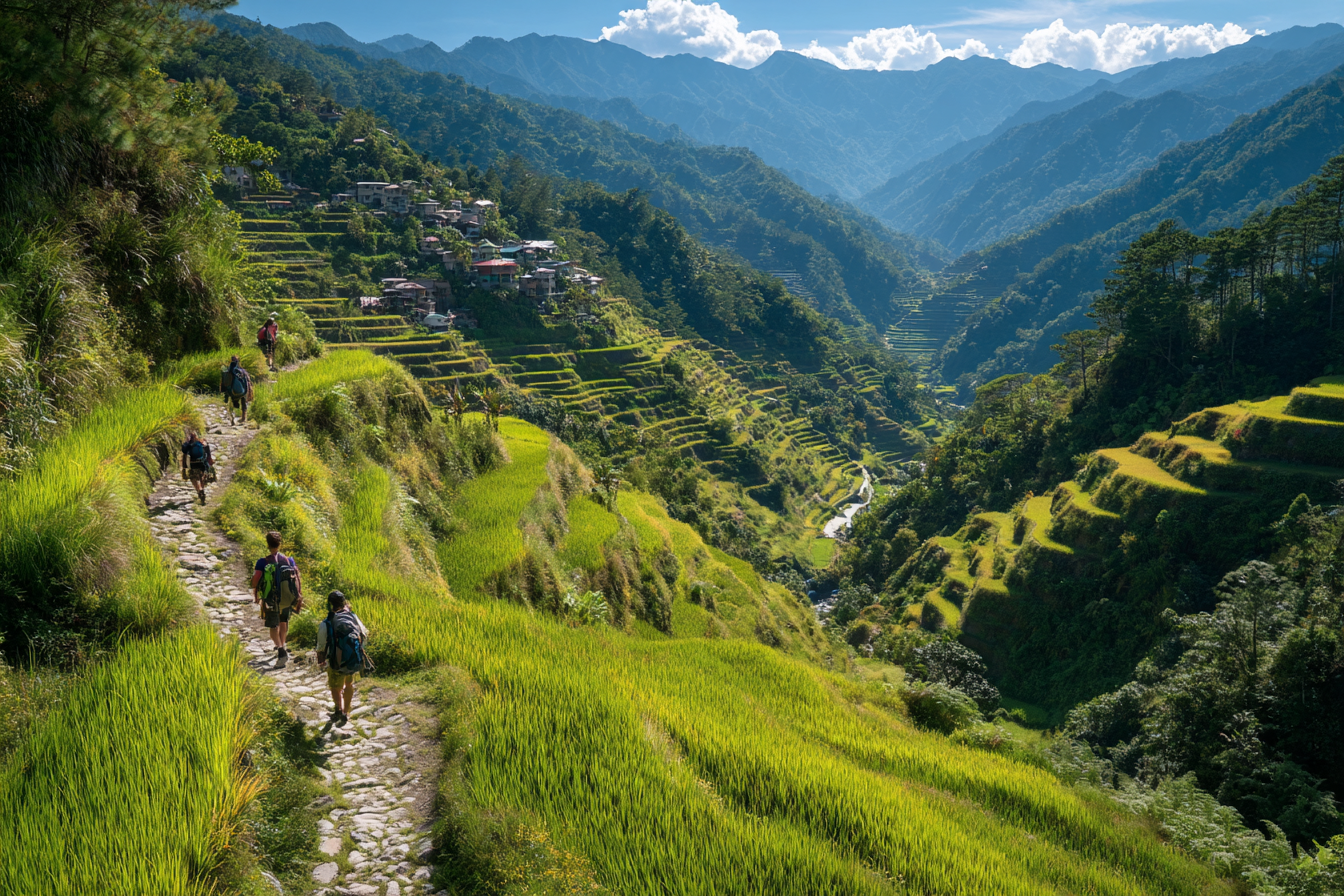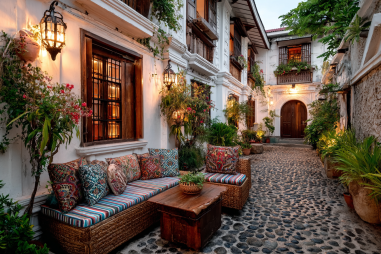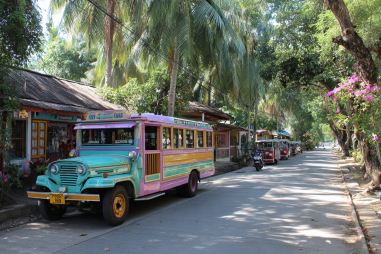Exploring the Banaue Rice Terraces is an unforgettable experience for any traveler heading to the Philippines. These terraces, often called the “Eighth Wonder of the World,” are an intricate system of rice paddies carved into the mountains by the Ifugao people over 2,000 years ago. While these stunning landscapes can be admired from afar, the best way to truly appreciate their grandeur and cultural significance is by embarking on Banaue trekking tours. Walking through the terraces, passing indigenous villages, and hiking into the heart of the Cordillera mountains offers an unparalleled adventure that blends outdoor exploration with rich heritage. If you’re considering a Banaue trek, read on to learn about popular routes, how to prepare, and what makes this hiking destination so special.
Popular Trekking Routes and Durations in Banaue
Banaue offers several trekking routes, each presenting different levels of difficulty and unique sights. Some are day hikes, while others are multi-day adventures that bring you deeper into the indigenous Ifugao culture.
- Banaue to Batad Village: This is the most popular trekking route, usually taking around 3-4 hours one way. The trail leads you to the famous Batad Rice Terraces, which are shaped like a giant amphitheater and considered some of the most spectacular terraces in the region.
- Banaue to Bangaan Village: A slightly less frequented route that takes roughly 4-5 hours each way. Bangaan is known for its charming tribal houses and terraced fields that have been preserved almost untouched by modernization.
- Banaue to Mayoyao Village: This longer trek can take 1-2 days and is ideal for hikers wanting a more immersive cultural experience. Mayoyao is home to the ancient tombs and Ifugao rituals and offers incredible panoramic views.
- Ifugao Rice Terraces Loop: More adventurous trekkers may opt for loop trails that connect several villages, often taking 3-4 days. These routes allow deeper exploration of the rice terraces and direct interaction with multiple indigenous communities.
Regardless of the route you choose, Banaue trekking tours provide access to breathtaking views, cultural heritage, and the chance to experience a way of life centered around these ancient rice fields.
Physical Requirements and Preparation for Trekking in Banaue
Although Banaue trekking tours vary in difficulty, many include steep, uneven trails and long hours of walking. It’s important to have a reasonable level of fitness before setting out. You should be comfortable walking several kilometers on hilly terrain, often at higher elevations.
If you’re new to trekking or want to improve your stamina, try regular cardio exercises like hiking, jogging, or brisk walking in the weeks leading up to your trip. Wearing sturdy, broken-in hiking shoes will also help prevent blisters and fatigue. Additionally, getting accustomed to carrying a day pack with all your essentials can make the journey easier.
Most guides recommend moderate fitness. However, trekking to remote villages like Batad or Mayoyao may require more endurance and mental preparation due to rugged paths and unpredictable weather. Make sure you’re well-rested and hydrated before embarking each day.
What to Bring for a Banaue Trekking Tour
Bringing the right gear is essential to ensure a comfortable and enjoyable trek. Here’s a list of recommended items to pack:
- Comfortable hiking shoes or boots with good traction
- Lightweight, breathable clothing layered for changing temperatures
- Rain jacket or poncho, especially if trekking during the rainy season (June to October)
- Hat and sunglasses for sun protection
- Reusable water bottle or hydration pack to stay hydrated
- Snacks or energy bars for quick fuel
- Camera or smartphone to capture the stunning landscapes
- Basic first aid kit including plasters, insect repellent, and any personal medication
- Cash in small denominations for purchasing local food, tips, or small souvenirs
- A lightweight backpack to carry your essentials comfortably
Since mobile network coverage can be spotty along the trails, it’s good to inform someone about your trekking plans beforehand and carry a map or GPS-enabled device.
Guided vs. Self-Guided Trekking Options
When planning your Banaue trekking tour, you can choose between guided hikes and self-guided treks. Each option has its own set of advantages:
Guided Tours
Taking a guided trek is highly recommended, especially for first-timers. Local guides are knowledgeable about trail conditions, weather changes, and cultural significance of the areas you visit. They can share fascinating stories about the Ifugao traditions, facilitate interactions with villages, and ensure your safety throughout the journey. Many tours include meals, accommodation, and transportation logistics, making for a hassle-free experience.
Self-Guided Trekking
For more experienced hikers who enjoy independence, self-guided treks are possible. However, this requires thorough preparation, including research on routes, securing maps, and understanding local customs. Since trail markers can sometimes be unclear, GPS navigation is essential. Make sure to inform local authorities or your accommodation about your plans.
Regardless of your choice, respecting the natural environment and the indigenous communities is paramount.
Highlights Along the Banaue Trek
Trekking in Banaue is not just about reaching the destination; it’s about savoring every moment along the way. Here are some of the key highlights you’ll encounter:
- Indigenous Ifugao Villages: Small villages nestled among the terraces showcase traditional wooden houses with thatched roofs. You’ll see locals engaged in farming, weaving, and everyday life that has remained largely unchanged for centuries.
- Stunning Terraced Landscapes: The rice terraces carved out of the mountains are covered in vibrant green during planting season and golden when the rice is ready for harvest. photo-worthy vistas abound throughout the trekking routes.
- Waterfalls and Natural Springs: Several treks pass by cool natural springs and waterfalls, perfect spots to rest and refresh.
- Viewpoints: Trails lead to panoramic lookouts where you can admire the full scope of the terraces sprawling across the mountains. Sunrise and sunset views are especially magical.
- Cultural Encounters: Meeting Ifugao people, learning about their customs, and possibly participating in traditional rituals or festivals adds a meaningful dimension to your journey.
Safety and Weather Considerations
The Banaue region experiences a tropical climate with a distinct rainy season from June to October. During this period, trekking conditions can become slippery and hazardous. It’s advisable to plan your trek during the dry season (November to May) for safer trails and clearer views.
Weather in the mountains can be unpredictable with sudden changes, so always check the local forecast before starting. Wearing layers and carrying rain gear helps you stay comfortable. Trekking with a guide ensures you are informed about trail conditions and emergency procedures.
Altitude is generally not extreme, but some trails remain physically challenging—make sure to pace yourself and communicate any discomfort to your guide.
The Role of Local Guides and Cultural Interactions
One of the most enriching aspects of trekking in Banaue is the opportunity to connect with the indigenous Ifugao community. Local guides play a crucial role in preserving cultural heritage while welcoming visitors. They serve as storytellers, historians, and cultural ambassadors, helping you understand the significance of the terraces and the way of life built around them.
Respect during your visit is important. Always ask permission before taking photos of people or their homes, support responsible tourism by buying local crafts, and follow guidance on preserving natural and cultural sites.
By choosing tours that employ local guides and supporting community-based tourism initiatives, your trekking experience contributes positively to the preservation of this unique cultural landscape.
Why Trekking Banaue Should Be on Your Travel List
Banaue trekking tours offer more than just physical activity; they provide a journey into one of the world’s oldest and most remarkable feats of agricultural engineering, intertwined with vibrant living culture. Whether you go for the breathtaking views, the cultural immersion, or the challenge of exploring mountainous trails, the experience is deeply rewarding.
Walking through the ancient terraces and quiet villages gives you a fresh perspective on sustainability, tradition, and human ingenuity. With its rich history and stunning natural beauty, Banaue is a must-do destination for adventurers and culture enthusiasts alike.
So lace up your hiking shoes, prepare your gear, and embark on a trek that will leave you with lasting memories and a profound appreciation of the Ifugao Rice Terraces.







